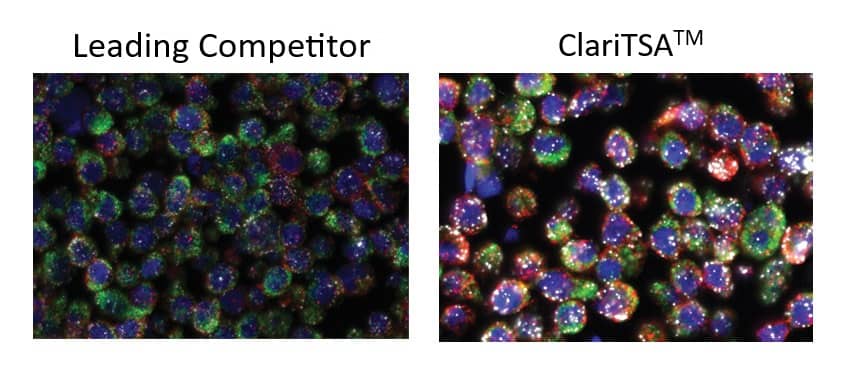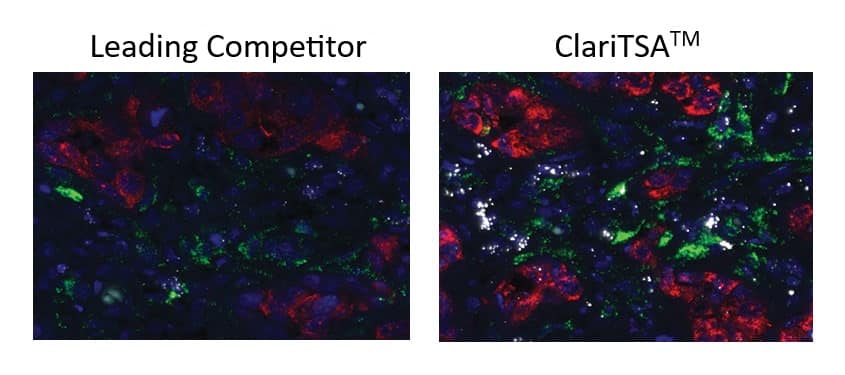Tyramide Signal Amplification (TSA)
Tyramide Signal Amplification (TSA), also known as Catalyzed Reporter Deposition (CARD), offers an effective way to efficiently enhance signal and detection capabilities for low-abundance targets in immunocytochemistry (ICC), immunohistochemistry (IHC), and in situ hybridization (ISH) applications.
Kits |
|
| Cat. No. | Product Name / Activity |
|---|---|
| 7523 | ClariTSA™ Fluorophore Kit 520 |
| Signal amplification kit for use in ISH, ICC and IHC | |
| 7526 | ClariTSA™ Fluorophore Kit 570 |
| Signal amplification kit for use in ISH, ICC and IHC | |
| 7527 | ClariTSA™ Fluorophore Kit 650 |
| Signal amplification kit for use in ISH, ICC and IHC | |
Other |
|
| Cat. No. | Product Name / Activity |
| 6241 | Biotinyl Tyramide |
| Reagent widely used for signal amplification in IHC and FISH | |
| 6457 | Cyanine 3 Tyramide |
| Orange fluorescent reagent widely used for signal amplification in IHC and FISH | |
| 6458 | Cyanine 5 Tyramide |
| Red fluorescent reagent widely used for signal amplification in IHC and FISH | |
| 7236 | Digoxigenin Tyramide |
| Reagent used for Tyramide Signal Amplification in IHC, ICC and ISH | |
| 6456 | Fluorescein Tyramide |
| Green fluorescent reagent widely used for signal amplification in IHC and FISH | |
Tyramide Signal Amplification (TSA), also known as catalyzed reporter deposition (CARD), offers an effective way to efficiently boost your signal and detection capabilities for low-abundance targets in IHC, ICC and FISH. HRP catalyzes the conversion of labeled inactive tyramide into a reactive radical, which then binds to adjacent tyrosine residues greatly enhancing the density of labeling. Tyramide reagents can be conjugated with a dye for fluorescent detection, or a hapten for antibody-based probing.
TSA can be used to enhance the signal of multiple targets on one sample by deactivating HRP using a peroxidase quenching buffer, then carrying out another round of TSA using a different set of antibodies from a different host species. Alternatively, the antibodies for the initial round of TSA can be stripped, leaving the covalently bound tyramides. TSA can then be repeated for the desired number of targets.

Figure 1: Tyramide Signal Amplification Principles: A primary and secondary antibody are used to label a tissue or cell sample. The secondary antibody is pre-conjugated to horseradish peroxidase (HRP), which in the presence of H2O2, catalyzes a labeled tyramide substrate into a highly reactive species that covalently bind to tyrosine residues on the proteins in close proximity to the antibodies and HRP, thus providing signal amplification.
Key Features of Tyramide Signal Amplification:
- Allows detection of low-abundance targets
- Used to enhance signals in IHC, ICC and FISH
- Reduces the amount of primary antibody required
- 100-fold more sensitive than conventional methods
- Simple, flexible, and easy to incorporate into IHC, IHC and FISH workflows
- Compatible with fluorescent multiplex systems
Featured Products: ClariTSA™ Fluorophore Kits
Our ClariTSA™ Fluorophore Kits are engineered for increased brightness and improved performance in ICC, IHC and FISH applications. They are specifically designed for optimal performance in the RNAscope™ Multiplex Fluorescent v2 Assay, enabling visualization of gene expression at the single cell level.
Key features of ClariTSA™ Fluorophore Kits:
- Optimized for use with the RNAscope™ Multiplex Fluorescent v2 Assay
- Suitable for multiplexing
- Brighter than equivalent competitor fluorophores
Figures 2 and 3 demonstrate the improved brightness of ClariTSA™ dyes in the RNAscope™ Multiplex Fluorescent v2 Assay versus a leading competitor.

Figure 2: 3-plex RNAscope™ Multiplex Fluorescent v2 Assay on HeLa cells with the leading competitor dyes (left) and the corresponding ClariTSA™ dyes 520, 570 and 650 (right). All dyes were used at 1:1500 dilution. Markers shown are Polr2a in green, PPIB in red and UBC in white. Nuclei are counter-stained with DAPI (Cat. No. 5748).

Figure 3: 3-plex RNAscope™ Multiplex Fluorescent v2 Assay on human lung cancer tissue with the leading competitor dyes (left) and the corresponding ClariTSA™ dyes 520, 570 and 650 (right). All dyes were used at 1:1500 dilution. Cancer immuno-oncology markers were probed: IDO-1 in green, KRT-19 in red and PD-1 in white. Nuclei are counter-stained with DAPI (Cat. No. 5748).
Tyramide Signal Amplification Protocol Outline for IHC and ICC
- Follow IHC/ICC protocol for fixing, permeabilizing and blocking cells/tissue sample
- Incubate with primary antibody
- Incubate with HRP-conjugated secondary antibody
- Incubate with dye-tyramide solution (e.g. Cyanine 3 Tyramide (Cat. No. 6457))
- Visualize and/or record fluorescence intensity or repeat TSA steps as necessary to label all targets (after either quenching HRP or removing antibodies)
Tyramide Signal Amplification Product Review
Find out how our customers have used and what they think of our 5-star TSA product Biotinyl Tyramide (Cat. No. 6241), as they share experimental details and images of their results.
Bio-Techne Antibodies for Immunofluorescence Assays
Bio-Techne family brands R&D Systems™ and Novus Biologicals provide the highest quality antibodies to support your research. We offer a comprehensive portfolio of over 40,000 IHC validated antibodies covering popular and unique targets.
Bio-Techne's Immunohistochemistry Handbook
This handbook provides a comprehensive introduction to IHC that is well-suited for researchers new to the technique or experienced scientists looking for a quick refresher. Download or request your copy of Bio-Techne's Immunohistochemistry Handbook.

Literature for Tyramide Signal Amplification (TSA)
Tocris offers the following scientific literature for Tyramide Signal Amplification (TSA) to showcase our products. We invite you to request* your copy today!
*Please note that Tocris will only send literature to established scientific business / institute addresses.
Fluorescent Dyes and Probes Research Product Guide
This product guide provides a background to the use of Fluorescent Dyes and Probes, as well as a comprehensive list of our:
- Fluorescent Dyes, including Janelia Fluor® Dyes
- Fluorescent Probes for Advanced Microscopy and Live Cell Imaging
- Fluorescent Probes to Support In Vivo, Deep Tissue, and Bioluminescence Imaging
- Fluorescent Probes and Reagents for Organoids and 3D Cell Culture Imaging
- Aptamer-based RNA Imaging Reagents
- Fluorescent Probes for Imaging Bacteria
- TSA VividTM Fluorophore Kits
- TSA Reagents for Enhancing IHC, ICC & FISH Signals
- Tissue Clearing Kits and Reagents
